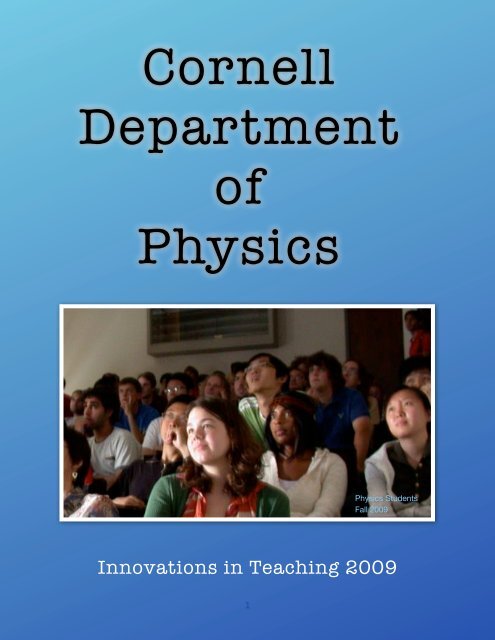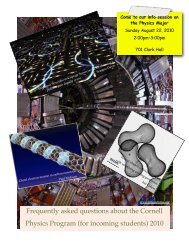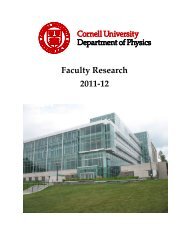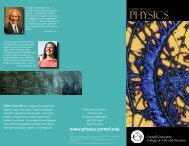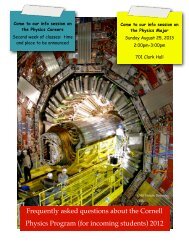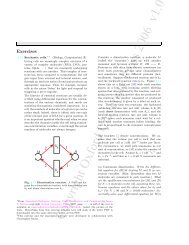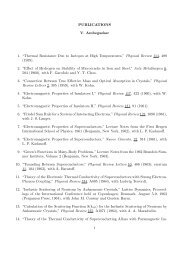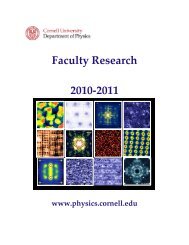C o r n e ll D e - Physics - Cornell University
C o r n e ll D e - Physics - Cornell University
C o r n e ll D e - Physics - Cornell University
- No tags were found...
Create successful ePaper yourself
Turn your PDF publications into a flip-book with our unique Google optimized e-Paper software.
Corne<strong>ll</strong>Departmentof<strong>Physics</strong><strong>Physics</strong> StudentsFa<strong>ll</strong> 2009Innovations in Teaching 20091
<strong>Physics</strong> is an exciting, living, discipline that continua<strong>ll</strong>y movesin new directions. <strong>Physics</strong> is a way of thinking and of solvingproblems -- it provides an analytic view of the world where thelanguage of mathematics finds expression as we<strong>ll</strong> as a set ofpowerful experimental tools which underlie much of scienceand technologyIn addition to our focus on world-class research, Corne<strong>ll</strong>’sDepartment of <strong>Physics</strong> is dedicated to educating the widestpossible range of students. The concepts of physics areimportant for a<strong>ll</strong> those interested in science and technology,and that the physicist’s approach to problem solving is broad inits applicability.We have invested our creativity into teaching, and have someof the most innovative courses in the country. We areimmersed in a culture of learning and teaching.Students studying thermodynamics in a P2213 lab2
Corne<strong>ll</strong> <strong>Physics</strong>:A history ofinnovationin teaching<strong>Physics</strong> Education Innovations byResearch PhysicistsCorne<strong>ll</strong> physicists have a long anddistinguished history of majorcontributions to physics education.They have developed new techniquesand new equipment, and written morethan a dozen widely used texts. Thephysicists at Corne<strong>ll</strong>who made the mostimpact on teachinghave also madesome of thegreatest impacts onscience. Forexample, BobRichardson, one of our department’sNobel laureates, played an importantrole in the development of one of ourmost innovative courses, <strong>Physics</strong> 101(now P1101).Electronic Response SystemIt is rare these days to see a largelecture course in the physical scienceswhich does not use “clickers” -- sma<strong>ll</strong>TV-remote like devices that a<strong>ll</strong>owstudents and their instructor tointeract via participate in-class po<strong>ll</strong>s.Electronic po<strong>ll</strong>ing transforms largeclasses, replacing lecturing with anactive engaging conversation in whichstudents answer questions and solveproblems, and in which the instructoruses immediate feedback to respondto their misconceptions. Po<strong>ll</strong>ing hasbeen popularized by instructors suchas Eric Mazur and Edward Redish,who encouraged students to discusstheir answers with each other beforeresponding (“peer instruction”) andMuch of the development ofelectronic po<strong>ll</strong>ing as aninstructional tool can be tracedto work at Corne<strong>ll</strong>.has beenvalidated asa powerfultool by manyyears ofphysicseducationresearch.Much of the development ofelectronic po<strong>ll</strong>ing as an instructionaltool can be traced to work at Corne<strong>ll</strong>.In the early 1970’s, Corne<strong>ll</strong> <strong>Physics</strong>Professors Don Holcomb and RaphaelLittauer designed and implementedthe first electronic po<strong>ll</strong>ing system forphysics education [Littauer, Ed. Tech.1, 69 (1972)]. The images at upper leftand upper right show the instructorand student interfaces Littauer wiredup in one of our large lecture rooms inRockefe<strong>ll</strong>er Ha<strong>ll</strong>. Littauer and otherCorne<strong>ll</strong> faculty developed and refinedlibraries of multiple choice questionsfor our introductory courses, andpioneered the use of po<strong>ll</strong>ing to guidestudent exploration of lecturedemonstrations. Littauer’s lectureswere known throughout the universityfor their engaging and entertainingstyle. The excitement when studentsin each new class first tried out thepo<strong>ll</strong>ing system was palpable.Littauer’s system was in continuoususe in our introductory physicscourses from 1971 until 2006.Innovative Teaching MethodsSome students enjoy and learnfrom lectures, while others preferindividual study. Some like a highlystructured and evenly paced learningenvironment, while others prefer towork on each subject in periods ofintense, focused activity. Catering tothese diverse learning styles is difficultin a traditional lecture course.In the 1970’s, Corne<strong>ll</strong> <strong>Physics</strong> andEducation faculty created thecountry’s first autotutorial physicscourse, <strong>Physics</strong> 101-102. Nothing likeit had ever been done before, and thewhole faculty was excited. With oneon-onesupport from faculty andgraduate students, undergraduateswould master worksheets, problem4
Videos produced by Bob Richardson in the early1980’s helped students in <strong>Physics</strong> 101/102 learnsets, and labs at their own pace.Unlike in a typical “Sage on theStage” style lecture course, thestudents would be empowered tocontrol their learning and becompletely engaged.We have learned a great dealabout this instructional format overthe last 309 years. As is detailedlater in this report, recentinnovations have made this coursemore successful than ever.Bringing State-of-the-ArtPedagogy to the ClassroomA<strong>ll</strong> of ourintroductoryclasses have beenupdated to usemodernpedagogicaltechniquesderived in partfrom physicseducationresearch. In the1990’s, RaphaelLittauer, BobSilsbee, and DonHolcomb led acomprehensive revision of ourintroductory physics sequence forlife science students (P207-208):the new curriculum focussed onproviding students with transferableski<strong>ll</strong>s relevant to a<strong>ll</strong> science andengineering disciplines; the lecturesbecame fu<strong>ll</strong>y interactive; problemsand exercises were developedwhich promoted conceptualunderstanding as an antidote topug-and-chug textbook problems;concept-rich and ski<strong>ll</strong>-richlaboratory exercises wereintroduced, and fu<strong>ll</strong>y integrated withthelectures. Similar updates havebeen percolating through our othercourses.TextbooksOur faculty are prolific writers,producing some of the country’sbest textbooks. Undergraduatetexts include Giambattista,Richardson, and Richardson’sinnovative introductory physicstextbook, Lou Hand’s “classicalMechanics”, Hassan Padamsee’s“<strong>Physics</strong> of the Heavens and Earth”,Vinay Ambegaokar’s “ReasoningAbout Luck”, and David Mermin’s“It’s about Time” (on specialrelativity.) Graduate texts includeclassics by Ashcroft and Mermin(Solid State <strong>Physics</strong>), Kurt Gottfried(Quantum Mechanics), SaulTeukolsky (Numerical Recipies, andBlaack Holes, White Dwarfs, andNeutron Stars). More recentgraduate texts include Jim Sethna’s“Statistical Mechanics” and BobSilsbee’s “Simulations for SolidState <strong>Physics</strong>”.Continuing the TraditionAs is clear by looking at theremainder of this report, the <strong>Physics</strong>Department’s drive for exce<strong>ll</strong>ence inteaching continues. Since 2004,Corne<strong>ll</strong> physics faculty have wonfive Faculty Innovations in Teaching(FIT) Awards, The Class of ’72Award for Innovation in Teaching,and a Faculty Appreciation Awardfrom Corne<strong>ll</strong>’s Fraternities andSororities. We have conductedmajor overhauls of several of ourintroductory courses, and haverenewed our faculty and staff byhiring those who believe in teachingexce<strong>ll</strong>ence. We continue tointroduce new techniques, newcurriculum, and new technology.5
DAGJ<strong>Physics</strong>1101-1102In addition to traditional lecture basedphysics courses, Corne<strong>ll</strong> offers a trulyunique style of introductory physicscourse: P1101/1102. This studentcenteredcourse gives participantsone-on-one instruction within aflexible framework.Novel format promotes studentcenteredlearningSince its beginning in the early1970’s, <strong>Physics</strong> 1101-1102 hasprovided a highly student-centered,mastery-focused alternative tolecture-based courses, givingparticipants one-on-one instructionwithin a flexible framework. It trainshundreds of students each year, actsas an incubator fornew approachesto physicseducation.Rather thanfo<strong>ll</strong>owing a rigidschedule oflectures, labs,and recitations,P1101/1102 students work semiautonomously,completingworksheets, problem sets, labs, andexams on the schedule which worksbest for them. Students areexpected to meet certain milestonesby given dates, but are free to workharder and faster faster, or to decidewhen in any given period they comeinto the physics lab. We provide awealth of resources to help themsucceed: printed notes, on-lineOur key philosophy in <strong>Physics</strong>1101 and 1102 is DAGJ[Do a good job]interactive tutorials, weekly“overview” lectures, and one-on-onetutoring from faculty, graduatestudents, and undergraduateteaching assistants. The latter havepreviously taken the course: they actas role models and have specialinsight into the time and studymanagement ski<strong>ll</strong>s that lead tosuccess. Students may get help atthe learning center on Sun-Fri from12:25pm to 10pm. Upon completinga module each student takes a test. .If they perform below theirexpectations, they can spend moretime studying and retake the test at alater date. Thistesting regimeTomas Ariasencouragesstudents todevelopmastery of thecoursematerial.Students with an interest inmedical careers form the mainclientele of P1101/1102, and mosttake the course as sophomores orjuniors This inte<strong>ll</strong>igent, driven andmature student body appreciates theflexibility of the self-pacedautotutorial format.Constant InnovationTomas Arias is currently headingup a major revision of P1101-1102,taking advantage of technologicaladvances, and improving theefficiency of these courses. Many ofthese changes are driven by studentfeedback. We listen carefu<strong>ll</strong>y to ourstudents, and try to craft a programwhich properly meets their needs.One of the most important toolswe have implemented is a set ofweb-based anonymous feedbackforms. We constantly urge studentsto comment freely, emphasizing thattheir comments won’t and can’t beheld against them, and receiveseveral messages per day. Thisprovides us with an unfilteredconnection to how the students feelabout a<strong>ll</strong> aspects of the course, anda<strong>ll</strong>ows us to respond faster and moreconstructively to their concerns. Thisinnovation is rapidly spreading to ourother introductory physics courses.Other web-based tools a<strong>ll</strong>owstudents to schedule meetings withfaculty and teaching assistants, andTAs and faculty to schedule theirhours in the Learning Center.6
P1101/1102 Learning CenterMeasuring SuccessAs instructors, we measuresuccess in an introductory physicscourse by the degree to whichstudents learn: physical concepts,problem solving ski<strong>ll</strong>s, transferablemath and science ski<strong>ll</strong>s. We alsoaim to have students emerge with apicture of physics as a unifieddiscipline, and foster curiosity aboutthe work around us.We reuse tests from year toyear, so we have detailedknowledge of our studentsperformance on an absolute scale.On this scale we have seenconstant improvement.The most clear metric of thesuccess of this course isattendance. Over the past fewyears we have seen steady growth,with a meteoric doubling in the lastyear. In course evaluation forms,students continua<strong>ll</strong>y say that theyfeel that they learned more from theautotutorial style class, and wouldrecommend the course to theirpeers.students with video lectures whichthey can watch to supplement theirwritten exercises. We continue toproduce videos of our overviewsessions, and have recently addeda series of video podcasts, 3-10minutes long, that focus on a singletopic/concept/ski<strong>ll</strong>.Interactive TutorialsWe have implemented a set ofconfidence-building online tutorialswhich walk students through theprocess of problem solving.Social Media drives co<strong>ll</strong>aborationStudents in P1101 takeadvantage of tools we provide toform study groups, and to helpeach-other with learning.Video podcastsSince the early 1980’s, we haveprovided physics 1101-1102Video Podcasts7
Making <strong>Physics</strong>Relevant<strong>Physics</strong>2207-2208Image of Taugannock fa<strong>ll</strong>s in IthacaNY used as part of a discussion ofthe continuity equation and fluid flow.How do you engage students? Makeyour material relevant. Lectures inP2207/2208 feature compe<strong>ll</strong>ing realworldapplications of the physicalprinciples. Recitations are studentcentered and include carefu<strong>ll</strong>y crafted“context rich” problems. Labs centeraround custom built activities whichwere designed specifica<strong>ll</strong>y for thiscourse and the students who take it.P2207/2208 instructors regularly po<strong>ll</strong>their studentsabout theirbackgroundand interests,then use thisinformation totarget thematerial. Thesepo<strong>ll</strong>s are also used to give feedback toour students -- for example, we useonline mathematics surveys to helpstudents identify the areas they needto focus on. Lectures are interactive,featuring three separate computerdrivenprojectors, concept questions,po<strong>ll</strong>ing, and student participation.Premed students are interested inphysics.The majority of students takingP2207/2208 are interested in HealthCareers. These smart, curious, andmotivated students want to know howthe world around them works. TheyInnovations are embarking in on a career Teaching path 2009(medicine) in which one is constantly8solving problems, interpreting data,and using sophisticated diagnostictools. P2207/2208 are introductoryphysics courses which emphasizestransferable ski<strong>ll</strong>s and connections tothe world around us. It provides thetechnical knowledge needed for thephysics portion of the MCAT whilebuilding the foundation for the physicsand mathematics they wi<strong>ll</strong> needthroughout their career.We strive to answer the question“What does physics have to dowith me?”ApplicationsWe haveproduced over60 differentpowerpointpresentationswhich take thephysical concepts from theP2207/2208 sy<strong>ll</strong>abus and show howthey apply in the world around us.Although many of these examples arebiological, we found that our studentsare interested in seeing a wide rangeof applications. Some of thesepresentations include ademonstration.A good example is our treatmentof elasticity. After first encounteringHooke’s law in lecture, studentsperform a laboratory exercise wherethey measure force-extension curvesfor a variety of spring configurations.They also explore the elasticproperties of rubber bands, seeinghow they are hysteretic and have a
soft nonlinearity where the forceneeded to stretch a band by 4 cm isless than twice the force needed tostretch it by 2 cm. In lecture theprofessor then performs ademonstration, measuring the forceextensioncurve of a cow’s aorta usingthe same apparatus that the studentsencountered in lab. Students see thatthe aorta has a hard nonlinearity,where the force needed to stretch theblood vessel by 4 cm is more thantwice the force needed to stretch it by2 cm. [Your earlobe has a similarproperty.] The class then discussesthe biological significance of thisnonlinearity, and how if blood vesselswere made of rubber they would besusceptible to embolisms. [Think of aba<strong>ll</strong>oon animal.]In-class po<strong>ll</strong>ingCorne<strong>ll</strong> has always been a leaderin using in-class student responsesystems, and concept questions havebeen fu<strong>ll</strong>y integrated into P2207/2208for many years.RF clickers gives students andteachers immediate feedback andhelps move towards more studentcenteredinstruction.Context rich problemsRather than the dry and abstractproblems typical of introductoryphysics courses, students encountercontext rich problems where thestudents must deal with some realworldscenario. They use theirknowledge of physics to formulatepossible solutions. These problemsare used extensively in recitationssessions, where the students worktogether, sharing ideas.These problems aresupplemented by online interactivequestions which give instantfeedback.Assistant Professor Matthias Liepe using aninteractive pen display during a P2207 lecture. Onevideo screen is contro<strong>ll</strong>ed by this touch-screen,while two others display prepared powerpoint slidesand videos. Similar to the previews which areshown before a movie, class announcements, trivia,and interesting physics facts are projected beforeclass begins.Doppler Ultrasound Imaging• Used to image blood flow and flow profiles.• Flow velocity ! Doppler frequency shiftVelocity distributiontimeApplications of Dopplereffect to medicalimagingBlood flow in the carotid arteryand jugular vein:Blood flow in a healthy thyroid gland:9
Tools forquantitative<strong>Physics</strong> 1112/2213/2214thinkingOur introductory sequenceP1112/2213/2214 provides ascaffolding which students usethroughout their studies of physicalsciences or engineering. Wedeveloped these courses using keyideas from physics educationresearch. These courses have astrong problem solving component,and help develop analytical modes ofthought. We have recentlyintroduced a new set of laboratoryexercises into P1112 which helpstudents grasp concepts of twodimensionalmotion.Diverse student populationrequires diverse teaching methods<strong>Physics</strong> 1112 involves a morediverse set of students than any ofour other introductory physicscourses. This is a required course forengineering students and is taken bymany students studying the physicalsciences. The freshmen in this classhave a wide range of priorexperiences: some have never seenphysics before, while others havetaken advanced placement courses.Many of them are quitemathematica<strong>ll</strong>y sophisticated, whileothers have basic conceptualI<strong>ll</strong>ustrations of energy stored in rotational motion used in <strong>Physics</strong> 1112.Left: Corne<strong>ll</strong> ultracentrifuge accident (1998).Center/Right: Industrial fly-wheel accident in early 20th century machine shop.10difficulties with calculus and algebra.We use a variety of techniques toconnect with this wide range ofstudents.One thing we have found is thatdespite the breadth of backgrounds,our students a<strong>ll</strong> have a great deal ofintuition about the physical world. Asincoming students this intuition istypica<strong>ll</strong>y conceptualized in anincorrect way, but it provides apowerful resource which we can useto teach physics.Peer InstructionOne of the best techniques forcapitalizing on students with mixedbackgrounds is to have the bestprepared students help teach theirpeers. <strong>Physics</strong> 1112 incorporatestwo hours per week of recitation,which are mostly run as cooperativeproblem solving sessions. Graduateand Undergraduate TeachingAssistants are forbidden fromlecturing during these sessions --instead they facilitate group-work.We use <strong>Physics</strong> EducationResearch inspired problems(including exercises from McDermottet al.’s Tutorials in Introductory<strong>Physics</strong>) to target areas wherestudents have the most difficulties.We also include context rich
problems, and open endedexplorations.<strong>Physics</strong> 1112 is one of the maincourses to use our undergraduatelearning assistants.Lectures<strong>Physics</strong> 1112/2213/2214 lecturesincorporate powerpoint presentations,concept questions, clickers, real-worldexamples, and interactive lecturedemonstrations.“Just in Time” teachingIn order to be able to customizeour instruction to the particular studentpopulation, we often employ “Just inTime” teaching techniques. Forexample, at the end of a lectureperiod, a short “pretest” might behanded out -- which studentscomplete before leaving theamphitheater. The instructor wi<strong>ll</strong> thenuse the results to help directConceptual LabsWe have designed laboratoryexercises for our introductory classeswhich directly target the conceptualdifficulties of students. We deemphasizelaboratory ski<strong>ll</strong>s (forexample we do not have studentsmaintain laboratory notebooks, butrather have them write theirobservations on prepared worksheets)in order to a<strong>ll</strong>ow the students to spendtheir time getting a strongerunderstanding of physics. We providemultiple views of the samephenomena: for example looking atmotion both with sonic rangers and bymaking measurements on videos theyrecord. Much of the data acquisitionis computerized, minimizing the moretedious aspects of laboratory work.Our labs are very successful atgetting students working together:typica<strong>ll</strong>y the apparatus cannot beoperated by a single student, and theanalysis inevitably requires discussion.The P1112 labs underwentsignificant revision in 2008. Severalcompletely new labs were introducedwhich focussed on understanding twodimensional motion.<strong>Physics</strong> 1112 lecture incorporating multimedia presentations,clicker questions, interactive lecture demonstrations, and realworldexamplesMotion Capture Laboratory exercises fromP1112. To learn about two dimensional motion,students work together to make and analyzestrobe diagrams from digital videos which theyrecord.11
Lecture DemonstrationsThrough the efforts of our teachingsupport specialists, Phil Krasicky andJenny Wurster, Corne<strong>ll</strong>’s <strong>Physics</strong>Department maintains one of therichest co<strong>ll</strong>ections of physicsdemonstrations in the country,archived and accessed through anonline catalog. We are in the processof enhancing this catalog with videorecordings of the demonstrationsSharing our demonstrationsMatthias Liepe has beenvideoing and cataloging ourdemonstrations at http://courses2.cit.corne<strong>ll</strong>.edu/physicsdemos. This publiclyaccessible catalog a<strong>ll</strong>ows a broaderrange of students and teachers tobenefit from our demonstrations.Training and TechniquesAlso acting as a lecturer, Philprovides training to our faculty andhas developed an approach todemonstrations that combines greatphysics with theatre and humor. Hismechanical resonancedemonstration, in which he playsCorne<strong>ll</strong>’s “Alma Mater” on an array ofwine glasses, is a perennial favorite.We integrate lecturedemonstrations with our clickerquestions, and use them to engageour students.Left: Lecture Demo StorageAbove: Videos of our Lecture Demos,Innovations in Teaching 2009available on the web12
Culture of scholarshipabout teaching andlearningOne key to our success at teaching isthe support our department providesto our instructors, and the ways inwhich our instructors share theirenthusiasm about teaching.<strong>Physics</strong> Education SeminarEvery few years Don Holcombruns a course on <strong>Physics</strong> Education,attended by graduate students andfaculty. It covers various moderntopics in physics education research.It is structured as a seminar course,with the participants givingpresentations throughout thesemester.Teaching and Learning <strong>Physics</strong>For the past 3 years we have beenoffering a course, “Teaching andLearning <strong>Physics</strong>,” aimed at bothundergraduate and graduate studentsinterested in physics pedagogy. It is a1.5 hour weekly seminar taught by ourteacher in residence: a career highschoolteacher spending a year atCorne<strong>ll</strong> to enhance our educationalmission. This is a required course forour undergraduate teachingassistants. It covers basic ideas ofeducation, such as epistomology andmetacognition, using introductoryphysics as a framework. This coursewas modeled after a similar onetaught by Noah Finkelstein at the<strong>University</strong> of Colorado.This course is highly interactive,and many good pedagogicaltechniques are modeled in it.Peer driven TA trainingEvery fa<strong>ll</strong>, current graduatestudents organize a two-dayworkshop on teaching, aimed at theincoming graduate students. Thisstudent-run structure is fun andeffective, with skits interspersed withmore formal instruction. There is afocus on making students aware thatthe mode of instruction which theyencountered as undergraduates is notnecessarily the most effective.Zen and the Art of Teaching <strong>Physics</strong>RecitationThis October the physicsdepartment sponsored a voluntaryone-day workshop for graduateteaching assistants. It was taught byour current teacher in residence andhis predecessor, and represented a“mini-version” of our course onteaching and learning physics. Theparticipants nearly unanimouslyagreed that it was a great success,giving them important tools whichCorne<strong>ll</strong> Institute for <strong>Physics</strong>TeachersWe involve educators frombeyond Corne<strong>ll</strong> in our scholarshipabout teaching and learning. Ourmost significant project is the Corne<strong>ll</strong>Institute for <strong>Physics</strong> Teachers (CIPT), aprogram cosponsored by the <strong>Physics</strong>Department, the Corne<strong>ll</strong> Center forNanoscale Systems, and the Corne<strong>ll</strong><strong>University</strong> School of ContinuingEducation and Summer Sessions.It develops activities forhighschool instructors to use in theclassroom, and maintaining a lendinglibrary of laboratory equipment, whichis freely available. The CIPT also putson two-week courses wherehighschool teachers come to Corne<strong>ll</strong>to learn and discuss ideas aboutphysics and ideas about teaching.This extremely valuable resource helpshighschool teachers maintain theirexcitement about physics andteaching, and helps them be part of alarger community.they could use in their teaching.Innovations Teaching 200913
Funding ourinnovationsCorne<strong>ll</strong>’s <strong>Physics</strong> department hasbeen extremely fortunate to have beenable to find the resources to supportour teaching efforts. These resourceshave come from Corne<strong>ll</strong>, and from thelarger community. We haveconsistently provided exce<strong>ll</strong>ent returnon these investments, using theseresources to make a large impact.Faculty Innovation in TeachingGrantsCorne<strong>ll</strong> physicists have benefittedgreatly from the Faculty Innovation inTeaching program: 2007 -- ErichMue<strong>ll</strong>er and Phil Krasiky, “Digital Videofor Studying 2D Mechanics”; 2007 --Matthias Liepe, “EnhancingIntroductory <strong>Physics</strong> Digita<strong>ll</strong>y”, 2006 --Raphael Littauer, Don Holcomb, andJeevak Parpia, “TechnologyResources for <strong>Physics</strong> 101-102”, 2005-- Jeevak Parpia, “Interactivedistributed learning and flexible testingfor autotutorial introductory physics”,2004 -- Robert Thorne, “InteractiveTools for Evaluation and TutorialSupport in Elementary ScientificMathematics”.<strong>Physics</strong> Teacher EducationCoalitionSince 2007, Corne<strong>ll</strong> has been aproud member of the <strong>Physics</strong> TeacherEducation Coalition (PhysTEC). Thisproject, supported by the NationalScience Foundation, the American<strong>Physics</strong> Society, the AmericanAssociation of <strong>Physics</strong> Teachers, andthe American Institute of <strong>Physics</strong>,aims to address the critical nationalshortage of qualified physics andphysical science teachers. Two thirdsof new physics teachers lack aphysics degree, and over 90% ofmiddle school physical sciencestudents are taught by teacherswithout a physical science major orcertification.Through a grant provided byPhysTEC, Corne<strong>ll</strong> has hired a teacherin residence, and implemented aprogram where we haveundergraduate teaching assistantshelp facilitate the recitation sections inour introductory courses. This bothbenefits pedagogy in the courses andhelps provide an early teachingexperience for possible teachers14NSF sponsored CentersMuch of our teaching activitieswhich involve community outreach aredirected through the various NSFsponsored centers: Corne<strong>ll</strong> Center forMaterial Science (CCMR), Center forNanoscale Science (CNS), and theLaboratory of Elementary Particle<strong>Physics</strong> (LEPP). Of particularimportance is the Corne<strong>ll</strong> Institute for<strong>Physics</strong> Teachers (CIPT), a programrun through the CNS.NSF single investigator grantsIndividual faculty efforts directedat education are often supported bythe National Science Foundationthrough individual investigator grants.The National Science Foundationmakes broader impact a key metric forInnovations in Teaching 2009judging grant proposals.
The FutureCorne<strong>ll</strong>’s Department of <strong>Physics</strong>intends to continue their strongrecord of teaching innovation. Wesee many cha<strong>ll</strong>enges andopportunities ahead, and wi<strong>ll</strong>continue to make education one ofour priorities.New FacilitiesCorne<strong>ll</strong>’s new physical sciencesbuilding wi<strong>ll</strong> be completed in Fa<strong>ll</strong>2010. This space, with a large atriumand coffee shop, wi<strong>ll</strong> become a keypart of the life of our undergraduates.We hope to use this space to fosterour educational mission.Physical Sciences LibraryIn December 2009 the physicalsciences library wi<strong>ll</strong> close. While wewi<strong>ll</strong> sorely miss this resource, itprovides a series of opportunities.Many in the physics department hopethat the physical sciences libraryspace can be repurposed forinstructional purposes. We envisionthat it could be used for large studioclassroomactivities, and also asinformal study space.Doubling InitiativeBoth the American PhysicalSociety and the AmericanAssociation of <strong>Physics</strong> Teachers haveca<strong>ll</strong>ed on the physics community toincrease the number of physicsgraduates. This is driven by the needfor a technica<strong>ll</strong>y ski<strong>ll</strong>ed workforce,and a shortage of highschoolteachers in Science, Technology,Engineering, and Mathematics.<strong>Physics</strong>, and science in general,is key to socioeconomic mobility, andinitiatives like this one help giveopportunities to the underprivileged.We are beginning a campaign toincrease the number of physicsmajors at Corne<strong>ll</strong>. We are particularlyfocussing increasing the diversity inour department, and targetingstudents interested in using theirbachelors degree to directly enter theworkforce or as a stepping stonetowards professional school.Continuing our mission of teachertrainingOne of our greatest successesover the last few years has been ourparticipation in the PhysTECprogram. Through this program weintroduced undergraduate learningassistants into our classrooms,offered courses on physicspedagogy, and directedundergraduates towards careers inteaching. With the funding for thiseffort coming to an end, we arelooking for ways to continue this verysuccessful project.Revisiting our CurriculumOur undergraduate curriculuminvolves a large number ofinterdependent courses. We havefour different streams of introductoryphysics, general education courses,and a wide range of intermediate/advanced courses. We areembarking on a careful evaluation ofthese courses, identifying wherethere are inefficiencies, and striving toimprove our educational outcomes.The first step in this process is tolook at our introductory sequence forengineers and physical sciencestudents, P1112-2213-2214, and thehonors version P1116-2217-2218.We wi<strong>ll</strong> look at questions of breadthvs depth, the synchronization oflectures with labs, and year-to yearcontinuity. We wi<strong>ll</strong> then move on tothe higher level courses. We wi<strong>ll</strong> bealert for opportunities where we cancombine courses with others offeredin the university in order to moreefficiently use resources.15
In memory of Raphael Littauer (1925-2009)Many have made important contributionsto our undergraduate program, butRaphael was a singular individual --passionate, insightful, and creative. Hewas an inspiration to the rest of the faculty,and wi<strong>ll</strong> be sorely missed.16W W W . P H Y S I C S . C O R N E L L . E D U


